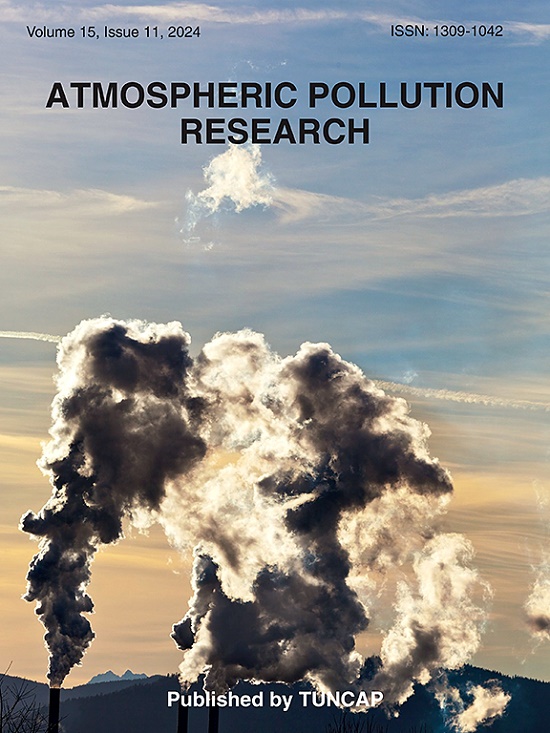Indoor air quality assessment of particulate matter levels in urban homes in India
IF 3.5
3区 环境科学与生态学
Q2 ENVIRONMENTAL SCIENCES
引用次数: 0
Abstract
Indoor air pollution with respect to particulate matter (PM) levels have not been investigated as intensively as those of outdoor pollution. In this pilot study, we address this gap by assessing indoor PM levels, the factors that influence it, and their spatio-temporal variations across four Indian cities: Delhi, Mumbai, Bangalore, and Mysore. We used low-cost monitors (LCMs) to measure residents’ PM exposure for ∼24–48 h. Average concentrations of PM1 were 60.0 ± 22.7 in Delhi, 34.0 ± 12.8 in Mumbai, 26.3 ± 3.9 in Bangalore, and 24.2 ± 8.0 μg m−3 in Mysore. PM2.5 (PM10) levels were 80.6 ± 26.5 (88.5 ± 24.4), 48.7 ± 17.3 (57.0 ± 17.6), 37.5 ± 5.9 (44.9 ± 8.4), and 33.2 ± 11.7 (38.7 ± 15.2) μg m−3, respectively (p < 0.05). The average daily indoor PM1 (PM2.5, PM10) during cooking was 30 % (32 %, 35 %) higher than that during non-cooking hours, and homes with longer cooking periods (≥2 h) showed ∼40 % higher PM levels. Indoor PM was strongly correlated to outdoor PM levels (R2 > 0.70). Indoor sources contributed only ∼10 % to the overall daily indoor PM levels, and the combined contribution of indoor and local outdoor sources to indoor PM was ∼33 %. Indoor PM employing the real-time LCS showed higher variability within homes than between homes, indicating that longer-term measurements should be conducted to accurately capture the variability. The study highlights that acute exposures are closely associated with short-term, temporarily generated indoor pollutants, while outdoor sources contribute significantly to chronic exposure to indoor PM.
印度城市家庭室内空气质量颗粒物水平评估
有关颗粒物(PM)水平的室内空气污染调查还没有像室外污染那样深入。在这项试验性研究中,我们通过评估印度四个城市的室内可吸入颗粒物水平、影响因素及其时空变化来填补这一空白:德里、孟买、班加罗尔和迈索尔。德里的 PM1 平均浓度为 60.0 ± 22.7,孟买为 34.0 ± 12.8,班加罗尔为 26.3 ± 3.9,迈索尔为 24.2 ± 8.0 μg m-3。PM2.5 (PM10)水平分别为 80.6 ± 26.5 (88.5 ± 24.4)、48.7 ± 17.3 (57.0 ± 17.6)、37.5 ± 5.9 (44.9 ± 8.4) 和 33.2 ± 11.7 (38.7 ± 15.2) μg m-3 (p <0.05)。烹饪期间室内 PM1(PM2.5、PM10)的日均浓度比非烹饪期间高 30%(32%、35%),烹饪时间较长(≥2 小时)的家庭的 PM 浓度高出 40%。室内可吸入颗粒物与室外可吸入颗粒物水平密切相关(R2 > 0.70)。室内污染源对每日室内可吸入颗粒物总体水平的贡献率仅为 10%,室内污染源和局部室外污染源对室内可吸入颗粒物的总贡献率为 33%。采用实时 LCS 测量的室内可吸入颗粒物在家庭内部的变异性高于家庭之间的变异性,这表明应进行更长期的测量以准确捕捉变异性。该研究强调,急性暴露与短期、临时产生的室内污染物密切相关,而室外污染源对室内可吸入颗粒物的慢性暴露有重要影响。
本文章由计算机程序翻译,如有差异,请以英文原文为准。
求助全文
约1分钟内获得全文
求助全文
来源期刊

Atmospheric Pollution Research
ENVIRONMENTAL SCIENCES-
CiteScore
8.30
自引率
6.70%
发文量
256
审稿时长
36 days
期刊介绍:
Atmospheric Pollution Research (APR) is an international journal designed for the publication of articles on air pollution. Papers should present novel experimental results, theory and modeling of air pollution on local, regional, or global scales. Areas covered are research on inorganic, organic, and persistent organic air pollutants, air quality monitoring, air quality management, atmospheric dispersion and transport, air-surface (soil, water, and vegetation) exchange of pollutants, dry and wet deposition, indoor air quality, exposure assessment, health effects, satellite measurements, natural emissions, atmospheric chemistry, greenhouse gases, and effects on climate change.
 求助内容:
求助内容: 应助结果提醒方式:
应助结果提醒方式:


